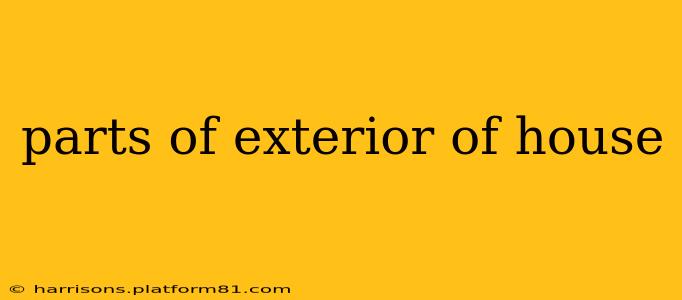The exterior of your house is its first impression, a statement of style, and a crucial element of its protection and value. Understanding its various parts is key to maintenance, repairs, and appreciating its overall aesthetic. This guide breaks down the key components, answering common questions homeowners often have.
What are the main parts of a house exterior?
The main parts of a house exterior are broadly categorized into structural components and finishing elements. Structural components provide the house's framework and protection from the elements, while finishing elements enhance its appearance and provide further weather protection. Let's explore these in more detail:
Structural Components:
- Foundation: This is the unseen but critical base, typically made of concrete, supporting the entire structure. Its condition is vital for the house's stability.
- Walls: These enclose the living spaces, often made of wood framing, brick, concrete block, or stucco. They offer structural support and insulation.
- Roof: This protects the house from rain, snow, and sun. It comprises several key parts, including the rafters, sheathing, underlayment, and roofing material (shingles, tiles, metal, etc.).
- Doors and Windows: These provide access to the interior and allow light and ventilation. They are crucial for energy efficiency and security.
Finishing Elements:
- Siding: This covers the exterior walls, offering weather protection and aesthetic appeal. Common types include vinyl, wood, brick, fiber cement, and stucco.
- Trim: This decorative molding is used around windows, doors, and the roofline, adding architectural detail and protecting the edges of the siding.
- Gutters and Downspouts: These channel rainwater away from the foundation, preventing water damage.
- Landscaping: While not strictly part of the house itself, landscaping significantly impacts the exterior's overall appearance and can protect the foundation from erosion.
What are the different types of house exteriors?
Many factors influence the choice of house exterior materials, including cost, climate, aesthetics, and maintenance requirements. Popular options include:
- Brick: Durable, fire-resistant, and low maintenance.
- Vinyl Siding: Affordable, low maintenance, and comes in various styles and colors.
- Wood Siding: Classic, aesthetically pleasing, but requires more maintenance.
- Stucco: Durable, weather-resistant, and can be applied over various underlying materials.
- Stone: Extremely durable and visually striking, but expensive and can be heavy.
What is the most important part of a house's exterior?
Arguably, the most important part of a house's exterior is the roof. It's the primary defense against the elements, protecting the entire structure from water damage, which can lead to costly repairs. A well-maintained roof is crucial for the longevity and structural integrity of the house.
What is the difference between cladding and siding?
The terms "cladding" and "siding" are often used interchangeably, but there's a subtle distinction. Cladding is a broader term that refers to any exterior covering, while siding is typically considered a specific type of cladding, usually applied horizontally to walls. Essentially, all siding is cladding, but not all cladding is siding.
How often should I inspect the exterior of my house?
Regular inspections are vital for preventing costly repairs. Aim for a thorough inspection at least twice a year, once in spring and again in autumn. Pay close attention to the roof, gutters, siding, and foundation for any signs of damage or deterioration.
What are some common exterior house problems?
Common exterior problems include:
- Cracked foundation: Requires professional attention.
- Water damage: Can lead to rot, mold, and structural problems.
- Damaged siding: Needs repair or replacement to prevent further damage.
- Clogged gutters: Can cause water damage to the roof and foundation.
- Pest infestations: Termites and other insects can cause significant structural damage.
Regular maintenance and prompt attention to any problems will extend the life of your home's exterior and protect your investment. Remember to consult with qualified professionals for significant repairs or if you're unsure about how to address specific issues.
